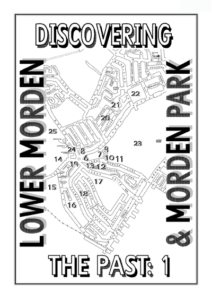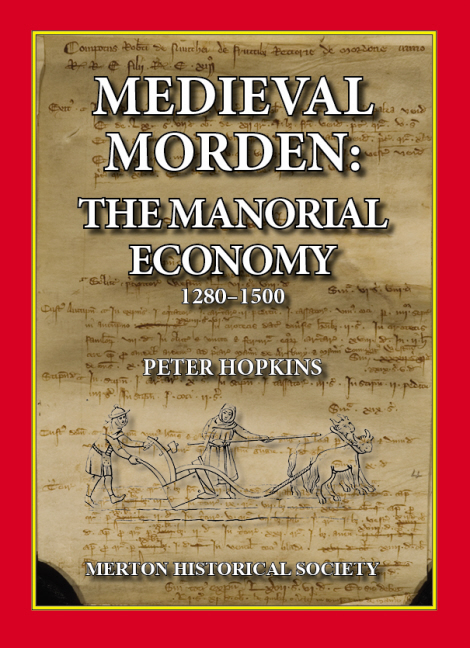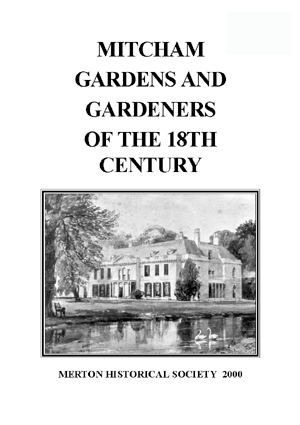Publications
Lord Monson’s Schooldays:

Reminiscences of Mitcham 1804-1809
Many of Mitcham’s large houses were occupied as private schools in the 18th and 19th centuries. For most of these we have no knowledge of life and learning. For one of these schools, however, we have a unique account – the sixth Baron Monson’s reminiscences of his schooldays at the Revd Richard Roberts’ Academy, in the house known in recent times as Glebelands.
Many of Lord Monson’s Mitcham schoolfellows later became prominent in politics, the church and society. His memoirs give interesting glimpses of some great men when they were boys.
Lost Common Lands – Merton Common
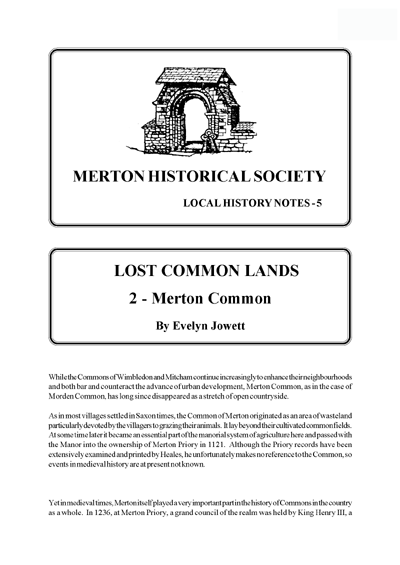
An account of how Merton Common was enclosed by means of a private Act of Parliament in 1816.
This article first appeared in the Merton Borough News as part of the series ‘The Merton Story’ on 15 and 22 March 1974. Miss E M Jowett , Vice President of the Society, died in August 1990.
Lost Common Lands – Morden Common
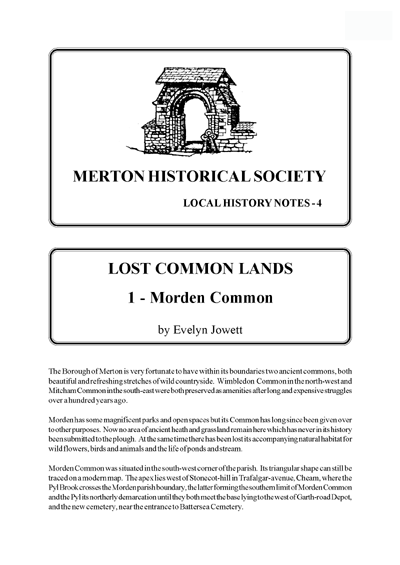
Morden Common, always small, shrank throughout the 19th century. The last open land was lost in the 1920s.
This article first appeared in the Merton Borough News as part of the series ‘The Merton Story’ on 8 March 1974. Miss E M Jowett , Vice President of the Society, died in August 1990.
Lower Morden and Morden Park
In producing this booklet of 25 double-spread pages, Peter offers us a rich source of material, most of which appears in print for the first time and is the result of a great deal of original research into a wide range of documentary sources. A general survey of Morden parish from AD 1 to the year 2000 leads the reader into a detailed account of 20 locations into which Peter has divided Lower Morden. The whole is illustrated with 47 maps and 39 photographs old and new.
Medieval Morden: Landscape and Landholding
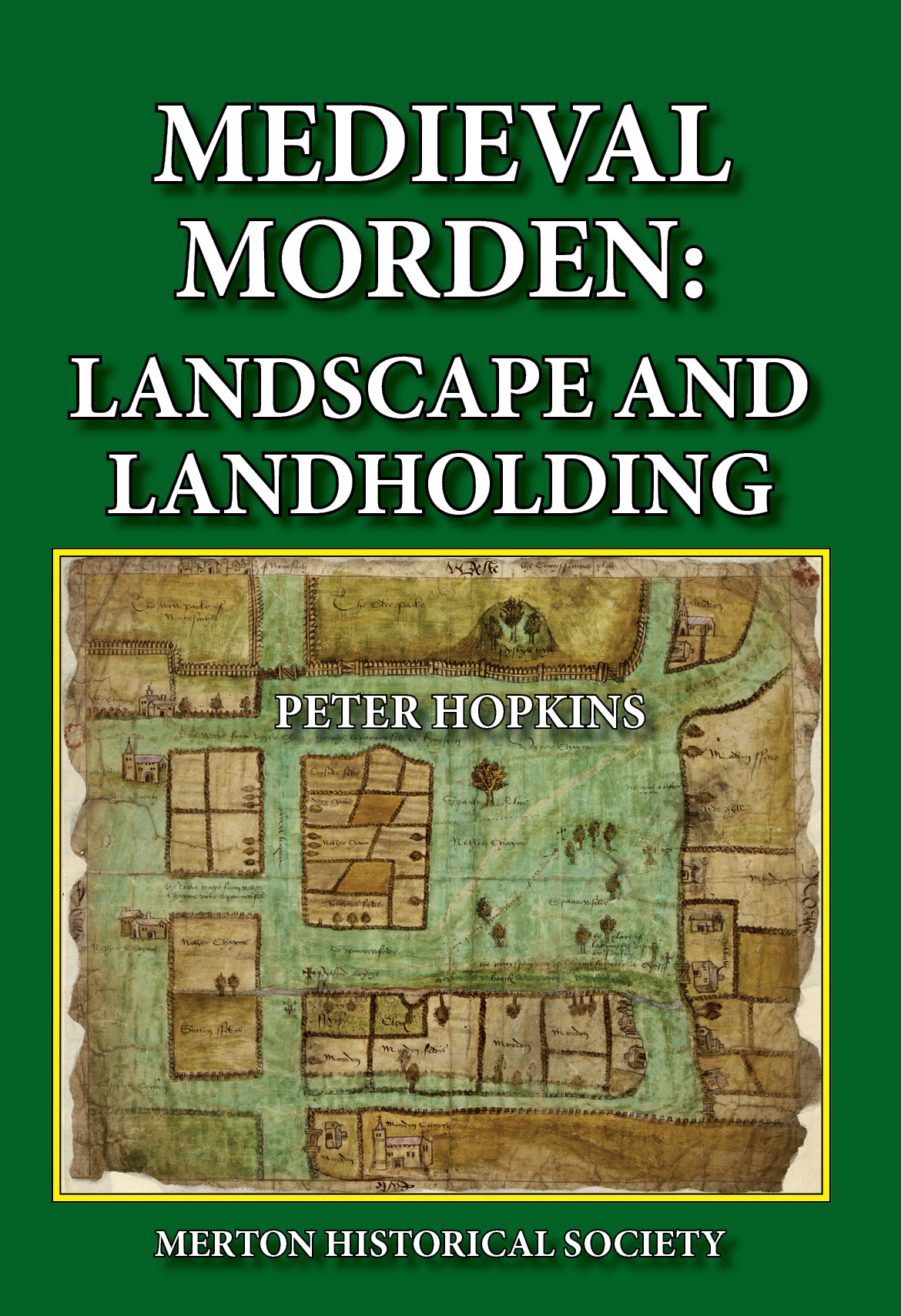
The second of three planned studies by Peter Hopkins into various aspects of medieval life as revealed through the surviving records, this volume seeks to reconstruct the changing topography of medieval Morden and investigates the various ways that property was held and transferred over the centuries..
Medieval Morden: Neighbourhood and Community
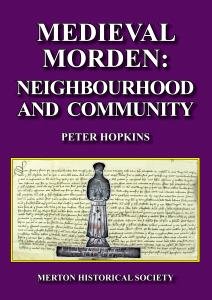 This study focuses on social interaction and community dynamics, in the light of the demands made of Morden’s inhabitants by the State, by the Church and in particular by Westminster Abbey as manorial lord, but also by the local community and the family. Most of the information comes from manorial court rolls, and the role and processes of the manor court are examined at the outset. Other chapters consider differences in status and in wealth, the role of credit, the evidence for conflict and cooperation and for the exercise of power and influence by local people. From brewers and bakers to priests and parishioners, this book explores the strengths and the tensions that worked together to form and to challenge a sense of neighbourhood and community in Morden especially in the centuries following the Black Death.
This study focuses on social interaction and community dynamics, in the light of the demands made of Morden’s inhabitants by the State, by the Church and in particular by Westminster Abbey as manorial lord, but also by the local community and the family. Most of the information comes from manorial court rolls, and the role and processes of the manor court are examined at the outset. Other chapters consider differences in status and in wealth, the role of credit, the evidence for conflict and cooperation and for the exercise of power and influence by local people. From brewers and bakers to priests and parishioners, this book explores the strengths and the tensions that worked together to form and to challenge a sense of neighbourhood and community in Morden especially in the centuries following the Black Death.
This volume also includes a substantial biographical register of over 1000 individuals who appear in the surviving records and who played their part in creating medieval Morden’s communal life.
Medieval Morden: The Manorial Economy
Peter Hopkins began his studies of Medieval Morden more than 20 years ago, by copying, transcribing and translating any and every medieval record relating to Morden that he could find.
Memoir of Priscilla Pitt, by John Marsh Pitt 1899
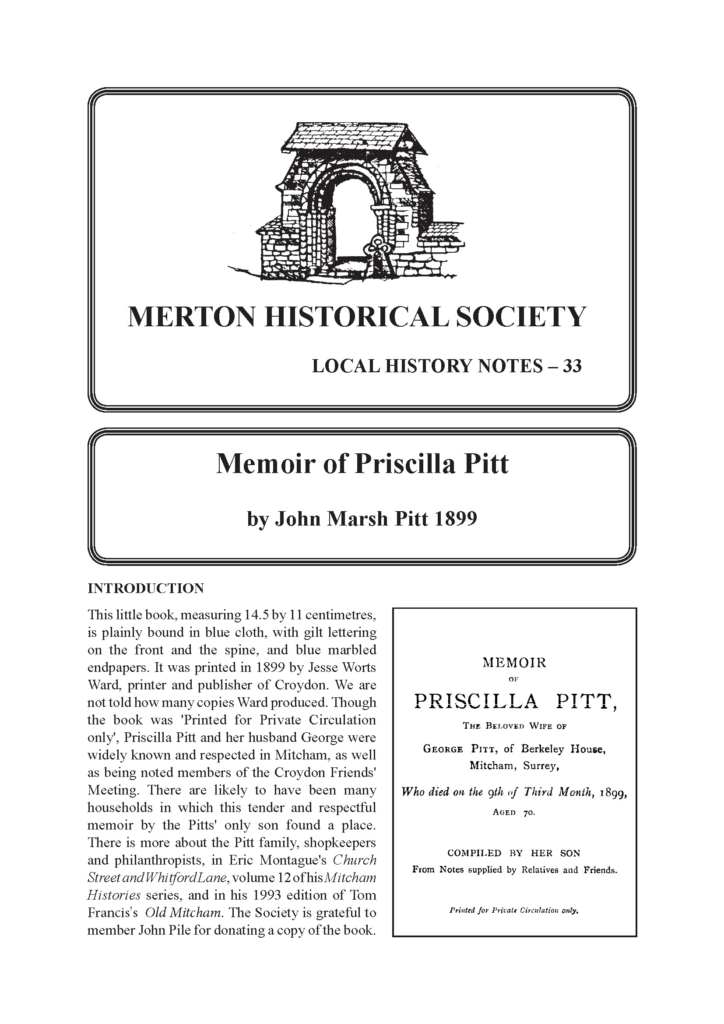
John Marsh Pitt produced this Memoir to his mother shortly after her death in 1899, and the Society is grateful to member John Pile for donating a copy of the book for reproduction. ‘This little book, measuring 14.5 by 11 centimetres, is plainly bound in blue cloth, with gilt lettering on the front and the spine, and blue marbled endpapers. It was printed in 1899 by Jesse Worts Ward, printer and publisher of Croydon. We are not told how many copies Ward produced. Though the book was ‘Printed for Private Circulation only’, Priscilla Pitt and her husband George were widely known and respected in Mitcham, as well as being noted members of the Croydon Friends’ Meeting. There are likely to have been many households in which this tender and respectful memoir by the Pitts’ only son found a place. There is more about the Pitt family, shopkeepers and philanthropists, in Eric Montague’s Mitcham Histories 12 Church Street and Whitford Lane, and in his 1993 edition of Tom Francis’s Old Mitcham‘.
Memories of a Morden Lad 1932-1957
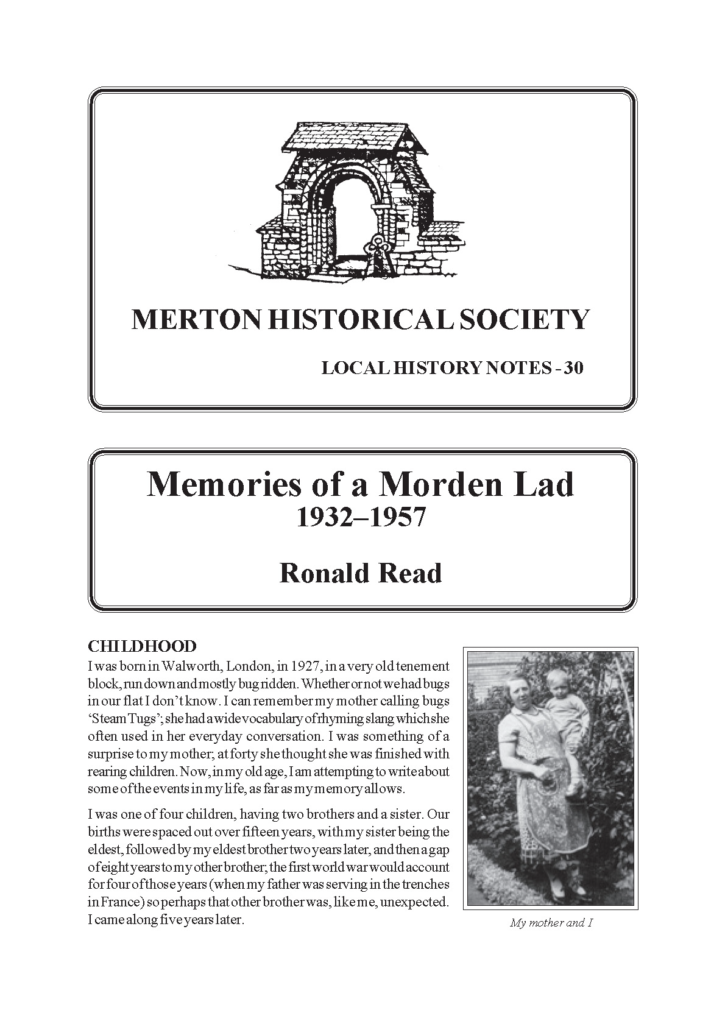
Local History Notes 30: by Ronald Read
Ronald Read recounts his childhood and wartime memories of growing up on the Morden part of the St Helier estate in the 1930s and 1940s. He then takes us to post-war Europe following his call-up to the army in 1945. His return to civilian life in Morden in 1948 was interrupted by 18 months spent in sanatoria in Waddon, Southbourne and Cheam, after he was diagnosed with TB in 1952. Mr Read expresses himself bluntly, and some readers might be offended by his language, but his account is a valuable, and fascinating, record of his life and experiences at home in Morden and further away. At 72 pages, this is our most substantial Note yet.
Memories of Lower Morden
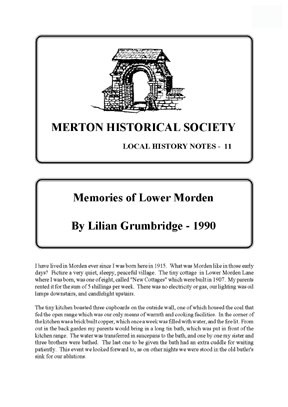
Lilian Grumbridge was born in one of the ‘New Cottages’ in Lower Morden Lane in 1915, and lived there until her marriage, when she moved to her present home in nearby Hillcross Avenue. Her memories of life in this tiny rural area, with its three farms, contrasts with life in the area today.
Memories of Morden between the Wars
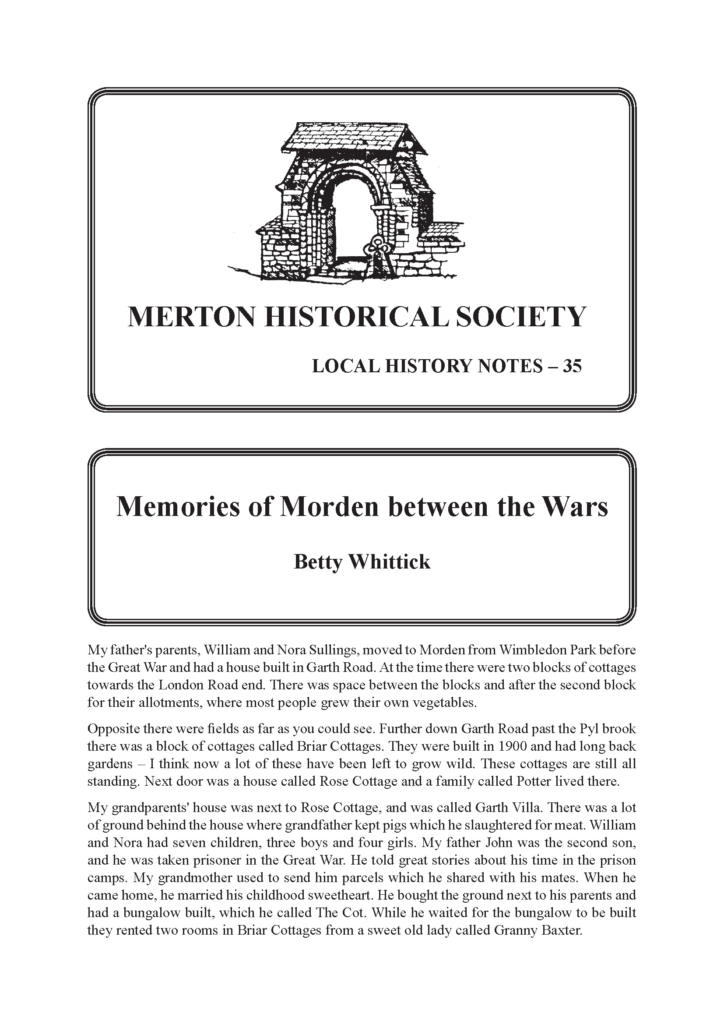
Betty Whittick relives her childhood in Garth Road. Those who heard Betty at our September 2012 ‘Chat Show’, or have listened to snippets on our website, have already had a foretaste of these fascinating reminiscences.
Memories of Service with the LDV/Home Guard, Mitcham 1940-42
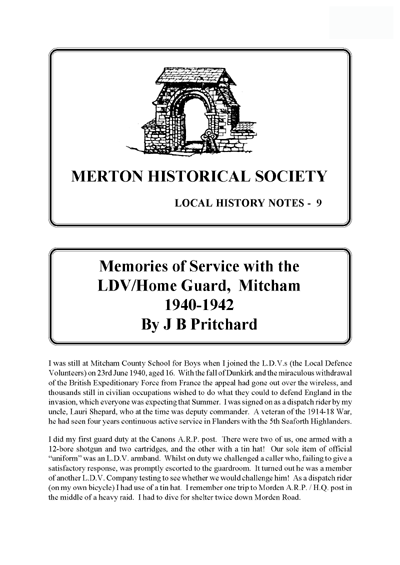
We have all laughed at ‘Dad’s Army’, but behind the mishaps and jokes was a very serious purpose. These notes by J B Pritchard give a clear, factual account of the formation, arming and training of the Mitcham Home Guard, formed to protect Mitcham against the threatened German invasion or any other hazard. A timely reminder of desperate measures needed in desperate times.
Memories of the New Merton Board Mills 1964-1976
by Robert Parkin
Merton digital classics
In the opening decades of the 20th century a number of publications appeared dealing with the history of Merton. These are now out of copyright so, as none of them seem to be currently available online, we have scanned our own copies.
Merton Priory monograph from MoLAS
Congratulations to Dave Saxby, Pat Miller and their colleagues for an excellent and very readable volume – well worth the long wait. The 296-page The Augustinian Priory of St Mary Merton: Excavations 1976-1990 is available from the Museum of London at £27.95 (ISBN 798-1-901992-70-0)
Miss Tate and her Almshouses
Faith, feminism and philanthropy in late Georgian and early Victorian England
Mitcham digital classics
In the 1920s two collections of Mitcham reminiscences were published under the title Old Mitcham I (1923) and II (1926). One of the articles included in these collections had been published separately in 1909 and another reprinted separately in 1932. They are all now out of copyright so, as none of them seem to be currently available online, we are very grateful to Merton Heritage Service for permission to scan photocopies of their copies found among the late Eric Montague’s papers.
Mitcham Gardens and Gardeners of the 18th Century
In Mitcham Gardens the author explores the surprisingly rich history of 18th-century horticulture in Mitcham, manifested by plantations, shrubberies, walled gardens, glasshouses and gravel walks, as local gentlemen vied with each other in this fashionable craze.
Mitcham in 1838: A Survey by Messrs Crawter & Smith
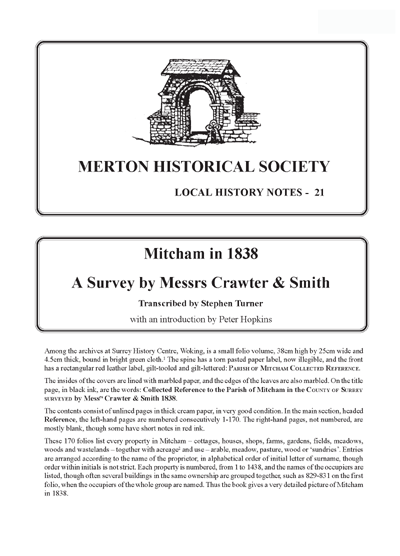
Among the archives at Surrey History Centre, Woking, is a small folio volume entitled Collected Reference to the Parish of Mitcham in the COUNTY OF SURREY SURVEYED by Messrs Crawter & Smith 1838. Its 170 folios list every property in Mitcham – cottages, houses, shops, farms, gardens, fields, meadows, woods and wastelands – together with acreage and use – arable, meadow, pasture, wood or ‘sundries’. Each property is numbered, from 1 to 1438, and the names of the occupiers are listed, though often several buildings in the same ownership are grouped together. Thus the book gives a very detailed picture of Mitcham in 1838.
Mitcham in 1846: The Tithe Apportionment Map
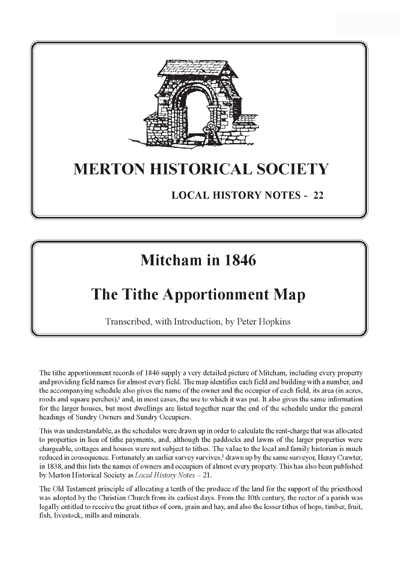
The tithe apportionment records of 1846 supply a very detailed picture of Mitcham, including every property and providing field names for almost every field. The map identifies each field and building with a number, and the accompanying schedule also gives the name of the owner and the occupier of each field, its area (in acres, roods and square perches), and, in most cases, the use to which it was put. It also gives the same information for the larger houses, but most dwellings are listed together near the end of the schedule under the general headings of Sundry Owners and Sundry Occupiers.
 MERTON HISTORICAL SOCIETY
MERTON HISTORICAL SOCIETY 